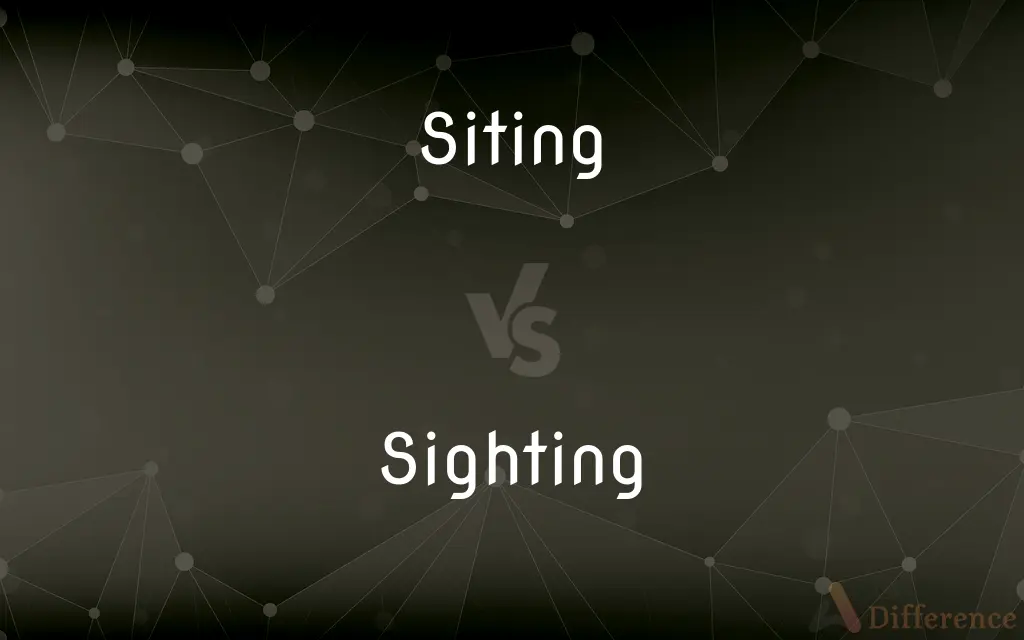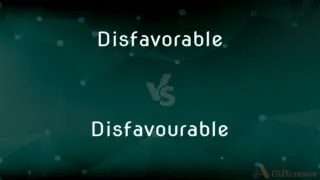Siting vs. Sighting — What's the Difference?
By Maham Liaqat & Fiza Rafique — Updated on March 22, 2024
Siting refers to the placement or location of something, while sighting involves observing or catching sight of something.

Difference Between Siting and Sighting
Table of Contents
ADVERTISEMENT
Key Differences
Siting is the process of selecting a location or positioning something strategically, often used in contexts such as construction, urban planning, or setting up equipment. On the other hand, sighting pertains to the act of seeing or observing something, particularly something rare or significant, such as wildlife, a celestial event, or an unusual occurrence.
In the realm of urban planning or construction, siting is a critical decision-making process that involves evaluating various factors like environmental impact, accessibility, and compliance with zoning laws. Whereas, in wildlife conservation or astronomy, sighting provides valuable data about the behavior, location, or existence of specific animals or celestial bodies.
Siting decisions are influenced by technical, environmental, and social considerations, aiming to optimize the location for specific purposes, such as minimizing noise pollution for residential areas or maximizing sun exposure for solar panels. In contrast, sightings can be spontaneous or the result of systematic observation efforts and can lead to exciting discoveries or important confirmations in fields like biology or astronomy.
The significance of siting extends to its implications on sustainability, community well-being, and resource management, underscoring the importance of careful planning and analysis. Sightings, while often more associated with observation and reporting, can impact scientific research, conservation efforts, and even public interest in natural phenomena or exploration.
Both siting and sighting require a keen eye for detail but in different contexts; siting is about foresight and planning for future utility and impact, whereas sighting is about noticing and documenting the present occurrence or appearance of something notable.
ADVERTISEMENT
Comparison Chart
Definition
The act of choosing a location for something.
The act of seeing or observing something.
Context
Used in construction, urban planning, energy projects.
Often used in wildlife observation, astronomy.
Key Considerations
Environmental impact, accessibility, regulations.
Visibility, rarity, significance of the observation.
Outcome
A decision on where to place or construct something.
Identification or documentation of an observation.
Impact
Influences future utility, compliance, and sustainability.
Contributes to knowledge, research, or public interest.
Compare with Definitions
Siting
Involves strategic planning and environmental assessment.
Urban planners are involved in the siting decisions for community parks to ensure accessibility.
Sighting
Observing or catching sight of something, often of interest or significance.
The sighting of a rare bird in the area excited local birdwatchers.
Siting
Affects long-term functionality and integration into surroundings.
Careful siting of wind turbines minimizes visual and noise impact on nearby communities.
Sighting
Common in wildlife observation, exploration, and surveillance.
Astronomers celebrated the sighting of a new comet passing close to Earth.
Siting
Factors like zoning laws, environmental impact, and community needs.
Siting a new school involves analyzing population density and traffic patterns.
Sighting
Can provide evidence of presence, behavior, or changes.
Sighting endangered animals helps in tracking their population and habitat usage.
Siting
Focuses on planning and location choice.
Siting decisions require extensive evaluation and consultation with stakeholders.
Sighting
Leads to recording or reporting the observation for further analysis.
Each sighting of the migrating whales adds to our understanding of their travel patterns.
Siting
Choosing and establishing a location for a specific purpose or facility.
The siting of the new solar farm considered sunlight patterns and land use restrictions.
Sighting
Concerned with the act of observing rather than planning.
Wildlife sightings contribute to biodiversity records and conservation strategies.
Siting
The action of locating something in a particular place
Decisions concerning the siting of nuclear power plants
Sighting
The act of catching sight of something, especially something unusual or searched for
A sighting of a whale in the harbor.
A reported sighting of a UFO.
Siting
The place where a structure or group of structures was, is, or is to be located
A good site for the school.
Sighting
The act of catching sight of something, especially something searched for.
There will be a small prize for the first sighting of a seal.
Siting
The place or setting of something
A historic site.
A job site.
Sighting
Present participle of sight
Siting
A website.
Sighting
The act of observing;
Several sightings of enemy troops were reported
Siting
To situate or locate on a site
Sited the power plant by the river.
Siting
Present participle of site
Siting
Misspelling of citing
Siting
Misspelling of sitting
Siting
The act of finding a site for something.
Common Curiosities
What does siting involve?
Siting involves choosing an optimal location for a facility or structure based on various criteria like environmental impact and accessibility.
What is a sighting in context of wildlife?
In wildlife context, a sighting refers to the observation of an animal, which can be rare or common, in its natural habitat.
What are key considerations in siting a renewable energy project?
Key considerations include environmental impact, proximity to transmission lines, land availability, and local regulations.
How do siting decisions impact the environment?
Siting decisions can significantly impact the environment by affecting land use, local ecosystems, and the sustainability of a project.
How do professionals approach siting for industrial projects?
Professionals use criteria like environmental assessments, community impact, and logistical considerations to make siting decisions.
How do sightings contribute to scientific research?
Sightings can provide valuable data for research, such as documenting species presence, behavior, or noting astronomical phenomena.
Is siting relevant only in urban planning?
While siting is crucial in urban planning, it is also relevant in many other fields like energy, conservation, and infrastructure development.
What makes a wildlife sighting significant?
A sighting can be significant if it involves rare, endangered, or previously unobserved animals, contributing to biodiversity knowledge.
Can the general public contribute to sighting reports?
Yes, citizen science projects often encourage the public to report sightings of wildlife, celestial events, or other phenomena of interest.
Can a sighting be of something other than animals?
Yes, sightings can include celestial events, ships, aircraft, or even unexplained phenomena, not just animals.
Share Your Discovery

Previous Comparison
Milady vs. Lady
Next Comparison
Disfavorable vs. DisfavourableAuthor Spotlight
Written by
Maham LiaqatCo-written by
Fiza RafiqueFiza Rafique is a skilled content writer at AskDifference.com, where she meticulously refines and enhances written pieces. Drawing from her vast editorial expertise, Fiza ensures clarity, accuracy, and precision in every article. Passionate about language, she continually seeks to elevate the quality of content for readers worldwide.















































